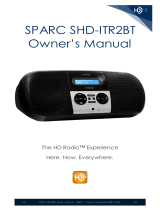
10
GB
setting will be shown on the radio’s display.
2. Rotate the Tuning button to select [Alarm 1] or [Alarm
2], and push in and release the Tuning button to enter
the setting.
3. Select [On] or [Off] to enable or disable the selected
alarm. If [Off] is selected, the radio will display a
message indicating that the selected alarm has been
saved. The alarm will now be disabled, the alarm’s
indicator will no longer be shown on the radio’s display,
and the radio will return to the selected mode.
4. If [On] is selected, rotate the Tuning button to select
the desired alarm hour (if the radio is using the 12 hour
time format, keep rotating to switch between AM and
PM), and push in and release the Tuning button to set
the alarm hour.
5. Rotate the Tuning button to select the desired alarm
minutes, and push in and release the Tuning button to
set the alarm minutes.
6. Next, the radio will allow you to select the alarm
frequency. Rotate the Tuning button to select [Once],
[Daily], [Weekdays] or [Weekends] as the alarm
frequency, and push in and release the Tuning button
to conrm your choice.
7. Then, the radio allows you to select the alarm source.
Rotate the Tuning button to select [FM], [AM] or
[Buzzer] as the alarm source, and push in and release
the Tuning button to conrm your choice. If [Buzzer]
is chosen in this step, proceed to step 9.
8. If [AM] or [FM] is chosen in step 7, the radio station
that will be played when the alarm is activated has to
be selected in this step. Rotate the Tuning button to
select the desired preset station or the last listened
station as the alarm station, and push in and release
the Tuning button to conrm your choice.
9. Finally, the alarm volume still has to be configured.
Rotate the Tuning button to select the desired alarm
volume, and push in and release the Tuning button to
conrm your choice.
After setting an alarm, the radio will display a message
indicating that the selected alarm has been saved (e.g.
“Alarm 1 saved”) and the alarm symbol will appear on
the radio’s display to indicate that the alarm has been
enabled.
Snoozing or stopping alarms
When an alarm is activated, it will start softly and
gradually increase in level (Humane Wake System) and
remain active for 60 minutes. Alarms can be stopped
by pressing Power / Sleep button, or snoozed for the
snooze time that is configured in the radio’s menu by
pressing or rotating any other button. For AM / FM radio
alarms, the Volume button can be used to control the
alarm’s volume.
Setting the sleep timer
The HDR-19 also features a sleep timer, which can be set
by following these steps:
1. Press and hold the Power / Sleep button for 2-3
seconds until a beep is heard and “Sleep Time” is
shown on the display.
2. Rotate the Tuning button to select the desired sleep
time (15-180 minutes), and push in and release the
Tuning button to conrm the sleep time.
3. If you want to check the remaining time of a sleep timer,
repeat step 1. To cancel a sleep timer, repeat step 1,
while selecting [Off] in step 2.
Configuring the Emergency Alerts feature
Emergency Alerts (EA) is a warning system used by
broadcasters to notify listeners about potential hazardous
situations related to extreme weather, floods, and
infrastructure failures, amber alerts (child abductions), and
more.
The HDR-19 must be in a location that allows for
adequate reception of audio and data services and tuned
into a station that provides the Emergency Alerts. When
Emergency Alerts are enabled, the Emergency Alerts
feature allows audio and text-based alerts to be played
or displayed by the radio. The alerts can also awaken the
radio from standby mode.
Enabling Emergency Alerts
Emergency Alerts can be enabled in any of the radio’s
modes by following these steps:
1. Press and hold the Info / Menu button for 2-3 seconds
until a beep is heard, and the menu is shown on the
display.
2. Rotate the Tuning button to select [Alert], and push in
and release the Tuning button to conrm your choice.
3. Rotate the Tuning button to select [On], and push in
and release the Tuning button to conrm your choice.
4. The radio will now ask if you want to dene a location.
Select [On] to dene a location, so that the radio will
only show local Emergency Alerts. Alternatively, select
[Off] to skip dening a location, so all the alerts that are
broadcast within the radio’s range will be received. If
[Off] is selected in this step, proceed to step 7.
5. The radio will now allow you to select a location preset.
The HDR-19 has 10 location presets that allow you to
easily switch between locations. Rotate the Tuning
button to select the desired location preset, and push in
and release the Tuning button to conrm your choice.
6. Next, rotate the Tuning button to select either of the
following options to provide location data:
●[State / County]: After selecting and conrming this
option, rotate and push in and release the Tuning
button to subsequently select and confirm a state
and a county, and proceed to step 7.
●[Zip]: After selecting and confirming this option,
rotate and push in and release the Tuning button to
enter the digits of a US ZIP code one by one from left
to right, and proceed to step 7.
●[Off]: After selecting and conrming this option, the
current preset is disabled. You can now proceed to
step 7.












